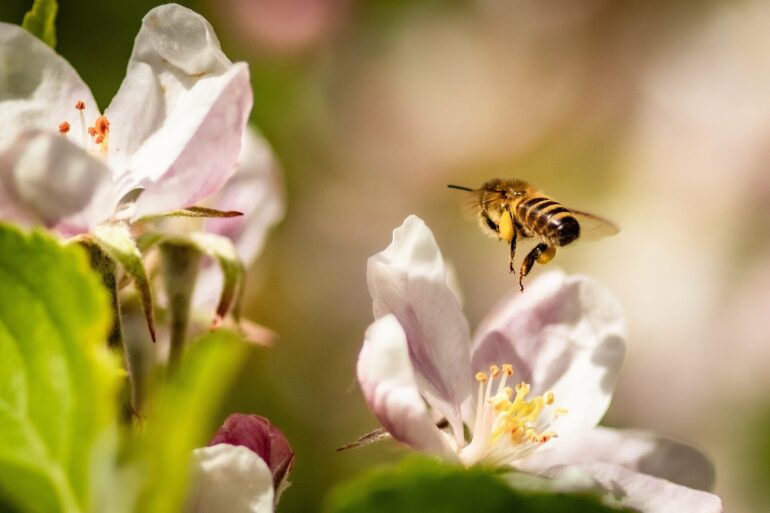Australian allodapines and European honey bees are distant relatives that converge to pollinate apple (Central Asian origin) in a Blue Mountains orchard.
New research led by Western Sydney University, in partnership with Hort Innovation, has delivered the most comprehensive assessment of pollination in apple crops in Australia by exploring pollination services provided by native and non-native bees for apple cultivation in Australia.
Published in Proceedings of the Royal Society B: Biological Sciences, the study observed the foraging behavior of over 69,000 invertebrate flower visitors to orchards for three years in the Blue Mountains and Central West regions of New South Wales to assess the effectiveness of pollination services.
As part of the study, a novel pollinator efficacy metric was developed to assess the services provided by bees which was customized for individual orchards in the study—this enables farmers to predict which kinds of bees are likely to be on-site based on proximity to native forests, habitat disturbance and weather conditions.
Lead author Dr. Simon Tierney from the Hawkesbury Institute for the Environment said that native bees enhance pollination services in the Northern Hemisphere, especially for cultivated apple crops, yet little is known about pollinators in the Southern Hemisphere.
Dr. Tierney explained the study is the most comprehensive assessment of pollination of apple crops in Australia and has international relevance because apples are the 10th most valuable global crop and account for about 10% of the value of the national fruit market, hence, the results were impactful.
“Understanding the natural history, behavior and family tree of bees is crucial for understanding pollination services because these animals co-evolved with flowering plants which represent approximately one-third of the average human diet (fruits and vegetables) and has ramifications for a range of global food industries which are a source of major economic importance, especially within Australia,” said Dr. Tierney.
“The apple orchards assessed in our study were found to be dependent on two bee species, one native stingless bee and the introduced western honey bee, but more broadly Australian apple production faces the potential vulnerability of being reliant upon a single species—the honey bee.”
The study highlighted that Australia houses a unique native bee fauna that consists of very old southern Gondwanan heritage and more recent arrivals from the north when the Australian tectonic plate bumped into southeast Asia.
However, as none of the top four bee pollinators for wild apples originating from Central Asia naturally occur in Australia, pollination services are more exposed to health risks from invasive parasites and associated disease.
“Without these naturally occurring Northern Hemisphere bee pollinators there may be an over-dependence on pollination services from the non-native honey bee whose health is currently under threat from an invasive parasite, the Varroa mite,” said Dr. Tierney.
“While the only other alternative native pollinator, a stingless bee, is effective, they only become important only on relatively warm spring days on farms that are within hundreds of meters of native forests and the distribution of stingless bees is restricted to the tropical and subtropical eastern seaboard of Australia. Whereas, more than 80% of Australian apple production occurs in temperate climates.”
In light of these new findings, the research team is advocating for continued long-term studies of pollinators of important food crops more generally and deployment of the pollinator metric developed in this study which enables customized assessments of pollination services for individual orchards based on climate, natural resources close to farms and an in-depth understanding of historical bee distributions and biogeography.
Hort Innovation chief executive officer Brett Fifield said this research is an integral part of the horticulture sector’s efforts into safeguarding pollination in Australia.
“Understanding the role honey bees and other native pollinators have in pollinating crops is vital information for the horticulture sector,” Mr. Fifield said. “These research insights will allow the horticulture sector to tailor its responses to pollination challenges.”
This study, “Bee pollination services and the burden of biogeography,” was part of the project “Healthy bee populations for sustainable pollination in horticulture,” part of the Hort Frontiers strategic partnership initiative developed by Hort Innovation.
More information:
Simon M. Tierney et al, Bee pollination services and the burden of biogeography, Proceedings of the Royal Society B: Biological Sciences (2023). DOI: 10.1098/rspb.2023.0747
Provided by
Western Sydney University
Citation:
Study finds apple pollination in Australia reliant on introduced species (2023, June 30)



